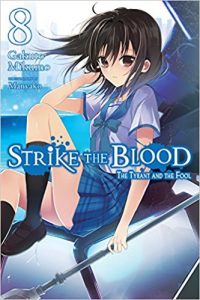By Gakuto Mikumo and Manyako. Released in Japan by ASCII Mediaworks. Released in North America by Yen On. Translated by Jeremiah Bourque.
I debated copying and pasting the start of my review of the 9th volume of Strike the Blood into this one, because the verses and chorus are the same. We get a new girl in peril, this time a Latin American girl (or the Strike the Blood equivalent) who is the titular Bride of the Dark God, and who gets mailed to Kojou in a suitcase to keep safe. She’s abusive and rude to Koujo, but gradually warms up to him after he keeps trying to save her life. Meanwhile, we get a new girl added to the “help Kojou summon a new Beast Vassal and regenerate to 100% health” rack, as Kanon (and Astarte, for added erotic appeal) allows him to drink her blood. And he and Yukina spend the entire book avowing that they aren’t boyfriend and girlfriend, while acting exactly like a couple would. There are no surprises, there is no ambition. It’s a predictable story, well told.
The cast is starting to get a little large and unwieldy, and so we winnow it down a bit for this book. Kojou and Nagisa’s dad takes Nagisa off for a shrine visit for the duration of the book, and Sayaka doesn’t even get mentioned, much less make an appearance. As for Asagi, who can’t actually leave the island, she ends up being locked in the computer room for her own safety, much to her annoyance. This allows Kanon and Astarte, who had not really done much at all lately, to make more of an impact. And then there’s Vattler, who sparks the plot here but doesn’t really show up till almost 2/3 of the way through the book. You get the sense he’s trying to be a trickster mentor to Kojou, putting him in life-or-death situations so that he can finally come into his own as the Fourth Primogenitor.
There’s also Celesta, the new girl I mentioned above. Her fury towards Kojou has a bit of the “Latin Spitfire” cliche to it, but she’s also the weak point of the book, as she’s a normal girl, so mostly exists to get into peril. Unlike a lot of the other heroines we’ve met in previous books, I’m not sure if we’ll actually end up seeing her again. Her peril does lead to some well-choreographed fights, though, and I expect that when this was animated it turned out quite well, given (as I’ve also said before) this reads like an anime novelization. She also resonates with Yukina in the “call Kojou a pervert” running gags, which are as tiresome as ever – I wouldn’t even mind the standard shonen jealous girl stuff if it were done well, but it’s tedious. The author is much better at drama than comedy, as most authors are.
So, in the end, Strike the Blood 10 doesn’t bring much new to the table. It’s a book to read if you’ve read the previous nine. But if you’ve read the previous nine, you won’t be too disappointed.





